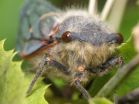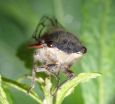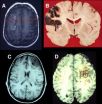(Press-News.org) DURHAM, N.C. -- Scientists have identified the developmental on-off switch for Streptomyces, a group of soil microbes that produce more than two-thirds of the world's naturally derived antibiotic medicines.
Their hope now would be to see whether it is possible to manipulate this switch to make nature's antibiotic factory more efficient.
The study, appearing August 28 in Cell, found that a unique interaction between a small molecule called cyclic-di-GMP and a larger protein called BldD ultimately controls whether a bacterium spends its time in a vegetative state or gets busy making antibiotics.
Researchers found that the small molecule assembles into a sort of molecular glue, connecting two copies of BldD as a cohesive unit that can regulate development in the Gram-positive bacteria Streptomyces.
"For decades, scientists have been wondering what flips the developmental switch in Streptomyces to turn off normal growth and to begin the unusual process of multicellular differentiation in which it generates antibiotics," said Maria A. Schumacher, Ph.D., an associate professor of biochemistry at the Duke University School of Medicine. "Now we not only know that cyclic-di-GMP is responsible, but we also know exactly how it interacts with the protein BldD to activate its function."
Streptomyces has a complex life cycle with two distinct phases: the dividing, vegetative phase and a distinct phase in which the bacteria form a network of thread-like filaments to chew up organic debris and churn out antibiotics and other metabolites. At the end of this second phase, the bacteria form filamentous branches that extend into the air to create spiraling towers of spores.
In 1998 researchers discovered a gene that kept cultured Streptomyces bacteria from creating these spiraling towers of fuzz on their surface. They found that this gene, which they named BldD to reflect this "bald" appearance, also affected the production of antibiotics.
Subsequent studies have shown that BldD is a special protein called a transcription factor, a type of master regulator that binds DNA and turns on or off more than a hundred genes to control biological processes like sporulation. But in more than a decade of investigation, no one had been able to identify the brains behind the operation, the molecule that ultimately controls this master regulator in Streptomyces.
Then scientists at the John Innes Centre in the United Kingdom -- where much of the research on Streptomyces began -- discovered that the small molecule cyclic-di-GMP is generated by several transcription factors regulated by BldD. The researchers did a quick test to see if this small molecule would itself bind BldD, and were amazed to find that it did. They contacted longtime collaborators Schumacher and Richard G. Brennan Ph.D. at Duke to see if they could take a closer look at this important interaction.
The Duke team used a tool known as x-ray crystallography to create an atomic-level three-dimensional structure of the BldD-(cyclic-di-GMP) complex.
BldD normally exists as a single molecule or monomer, but when it is time to bind DNA and suppress sporulation, it teams up with another copy of itself to do the job. The 3D structure built by the researchers revealed that these two copies of BldD never physically touch, and instead are stuck together by four copies of cyclic-di-GMP.
"We have looked through the protein databank and scoured our memories, but this finding appears to be unique," said Brennan, who is a professor and chair of biochemistry at Duke University School of Medicine. "We have never seen a type of structure before where two monomers become a functional dimer, with no direct interaction between them except a kind of small-molecule glue."
To confirm their findings, Schumacher determined several crystal structures from different flavors of bacteria (S. venezuelae and S. coelicolor) and came up with the same unusual result every time.
Now that the researchers know how cyclic-di-GMP and BldD can become glued together to turn off sporulation and turn on antibiotic production, they would like to know how the complex can become unglued again to flip the switch the other way.
The research was supported by a Long Term EMBO Fellowship (ALTF 693-2012), a Leopoldina Postdoctoral Fellowship, the Biotechnology and Biological Sciences Research Council (BB/H006125/1), the MET Institute Strategic Programme, and the Duke University School of Medicine.
INFORMATION:
CITATION: "Tetrameric c-di-GMP mediates effective transcription factor dimerization to control Streptomyces development," Natalia Tschowri, Maria A. Schumacher, Susan Schlimpert, Nagababu Chinnam, Kim C. Findlay, Richard G. Brennan, and Mark J.
Buttner. Cell, August 28, 2014.
Small molecule acts as on-off switch for nature's antibiotic factory
Tells Streptomyces to either veg out or get busy
2014-08-28
ELSE PRESS RELEASES FROM THIS DATE:
Second-hand e-cig smoke compared to regular cigarette smoke
2014-08-28
E-cigarettes are healthier for your neighbors than traditional cigarettes, but still release toxins into the air, according to a new study from USC.
Scientists studying secondhand smoke from e-cigarettes discovered an overall 10-fold decrease in exposure to harmful particles, with close-to-zero exposure to organic carcinogens. However, levels of exposure to some harmful metals in second-hand e-cigarette smoke were found to be significantly higher.
While tobacco smoke contains high levels of polycyclic aromatic hydrocarbons – cancer-causing organic compounds – the level ...
Healthy Moms program helps women who are obese limit weight gain during pregnancy
2014-08-28
PORTLAND, Ore., August 28, 2014 — A new study finds that women who are obese can limit their weight gain during pregnancy using conventional weight loss techniques including attending weekly group support meetings, seeking advice about nutrition and diet, and keeping food and exercise journals.
Results of the Healthy Moms study, published in Obesity, also show that obese women who limit their weight gain during pregnancy are less likely to have large-for-gestational age babies which can complicate delivery and increase the baby's risk of becoming obese later in life.
"Most ...
University of Montana cicada study discovers 2 genomes that function as 1
2014-08-28
MISSOULA, Mont. – Two is company, three is a crowd. But in the case of the cicada, that's a good thing.
Until a recent discovery by a University of Montana research lab, it was thought that cicadas had a symbiotic relationship with two important bacteria that live within the cells of its body. Since the insect eats a simple diet consisting solely of plant sap, it relies on these bacteria to produce the nutrients it needs for survival.
In exchange, those two bacteria, Hodgkinia and Sulcia, live comfortably inside the cicada. Since all three divvy up the nutritional roles, ...
Non-adaptive evolution in a cicada's gut
2014-08-28
Organisms in a symbiotic relationship will often shed genes as they come to rely on the other organism for crucial functions. But now researchers have uncovered an unusual event in which a bacterium that lives in a type of cicada split into two species, doubling the number of organisms required for the symbiosis to survive.
Cicadas of the genus Tettigades feed only on sap they suck out of plants. To create some of the essential amino acids they rely on two bacterial helpers — Candidatus Hodgkinia cicadicola and Candidatus Sulcia muelleri — with which they have lived in ...
How studying damage to the prefrontal lobe has helped unlock the brain's mysteries
2014-08-28
Until the last few decades, the frontal lobes of the brain were shrouded in mystery and erroneously thought of as nonessential for normal function—hence the frequent use of lobotomies in the early 20th century to treat psychiatric disorders. Now a review publishing August 28 in the Cell Press journal Neuron highlights groundbreaking studies of patients with brain damage that reveal how distinct areas of the frontal lobes are critical for a person's ability to learn, multitask, control their emotions, socialize, and make real-life decisions. The findings have helped experts ...
Circulating tumor cell clusters more likely to cause metastasis than single cells
2014-08-28
Circulating tumor cell (CTC) clusters – clumps of from 2 to 50 tumor cells that break off a primary tumor and are carried through the bloodstream – appear to be much more likely to cause metastasis than are single CTCs, according to a study from investigators at the Massachusetts General Hospital (MGH) Cancer Center. Their report in the August 28 issue of Cell also suggests that a cell adhesion protein binding CTC clusters together is a potential therapeutic target.
"While CTCs are considered to be precursors of metastasis, the significance of CTC clusters, which are ...
NYU researchers ID process producing neuronal diversity in fruit flies' visual system
2014-08-28
New York University biologists have identified a mechanism that helps explain how the diversity of neurons that make up the visual system is generated.
"Our research uncovers a process that dictates both timing and cell survival in order to engender the heterogeneity of neurons used for vision," explains NYU Biology Professor Claude Desplan, the study's senior author.
The study's other co-authors were: Claire Bertet, Xin Li, Ted Erclik, Matthieu Cavey, and Brent Wells—all postdoctoral fellows at NYU.
Their work, which appears in the latest issue of the journal Cell, ...
Zombie bacteria are nothing to be afraid of
2014-08-28
VIDEO:
Heidi Arjes of Washington University in St. Louis explains how the failsafes in the bacterial cell cycle work. A bacterium that fails to pass either failsafe enters a zombified state...
Click here for more information.
A cell is not a soap bubble that can simply pinch in two to reproduce. The ability to faithfully copy genetic material and distribute it equally to daughter cells is fundamental to all forms of life. Even seemingly simple single-celled organisms must have ...
Research shows how premalignant cells can sense oncogenesis and halt growth
2014-08-28
Cold Spring Harbor, NY -- What happens inside cells when they detect the activation of a cancer-inducing gene? Sometimes, cells are able to signal internally to stop the cell cycle. Such cells are able to enter, at least for a time, a protective non-growth state.
Since the 1980s, scientists have known that mutations in a human gene called RAS are capable of setting cells on a path to cancer. Today, a team at Cold Spring Harbor Laboratory (CSHL) publishes experiments showing how cells can respond to an activated RAS gene by entering a quiescent state, called senescence.
CSHL ...
Computer games give a boost to English
2014-08-28
If you want to make a mark in the world of computer games you had better have a good English vocabulary. It has now also been scientifically proven that someone who is good at computer games has a larger English vocabulary. This is revealed by a study at the University of Gothenburg and Karlstad University, Sweden.
The study confirms what many parents and teachers already suspected: young people who play a lot of interactive English computer games gain an advantage in terms of their English vocabulary compared with those who do not play or only play a little.
The study ...
LAST 30 PRESS RELEASES:
Exposure to wildfire smoke late in pregnancy may raise autism risk in children
Breaking barriers in lymphatic imaging: Rice’s SynthX Center leads up to $18 million effort for ‘unprecedented resolution and safety’
Dhaval Jadav joins the SETI Institute Board to help spearhead novel science and technology approaches in the search for extraterrestrial life
Political writing retains an important and complex role in the national conversation, new book shows
Weill Cornell Medicine receives funding to develop diagnostic toolbox for lymphatic disease
It started with a cat: How 100 years of quantum weirdness powers today’s tech
McGill researchers identify a range of unexpected chemical contaminants in human milk
Physical therapy research highlights arthritis’ toll on the workforce — and the path forward
Biomedical and life science articles by female researchers spend longer under review
Forgetting in infants can be prevented in mice by blocking their brain’s immune cells
Blocking immune cells in the brain can prevent infant forgetting
AI-driven ultrafast spectrometer-on-a-chip: A revolution in real-time sensing
World enters “era of global water bankruptcy”; UN scientists formally define new post-crisis reality for billions
Innovations in spatial imaging could unlock higher wheat yields
A twitch in time? Quantum collapse models hint at tiny time fluctuations
Community water fluoridation not linked to lower birth weight, large US study finds
Stanford University’s Guosong Hong announced as inaugural recipient of the SPIE Biophotonics Discovery’s Impact of the Year Award
Ice, ice, maybe: There’s always a thin layer of water on ice — or is there?
Machine learning lends a helping ‘hand’ to prosthetics
Noninvasive brain scanning could send signals to paralyzed limbs
Community water fluoridation and birth outcomes
SGLT2 inhibitors vs GLP-1 receptor agonists for kidney outcomes in individuals with type 2 diabetes
Long-term exposure to air pollution and risk and prognosis of motor neuron disease
Five-year absolute risk–based and age-based breast cancer screening in the US
Study finds elevated alcohol involvement in suicides of lesbian, gay and bisexual women
Air pollution may increase the risk of the neurodegenerative disease ALS
Chronic kidney disease poisons patients’ hearts, scientists discover
Hollings researchers reveal why some pancreatic tumors behave differently
DNA ties gut motility to vitamin B1
Study suggests pathway for life-sustaining conditions in Europa’s ocean
[Press-News.org] Small molecule acts as on-off switch for nature's antibiotic factoryTells Streptomyces to either veg out or get busy







